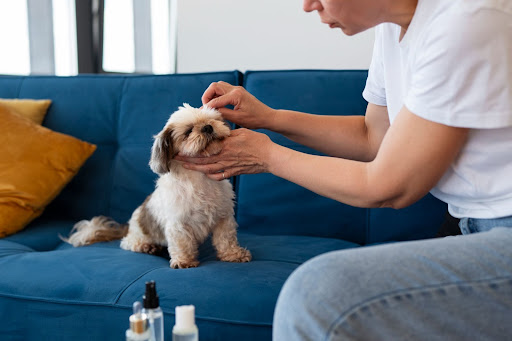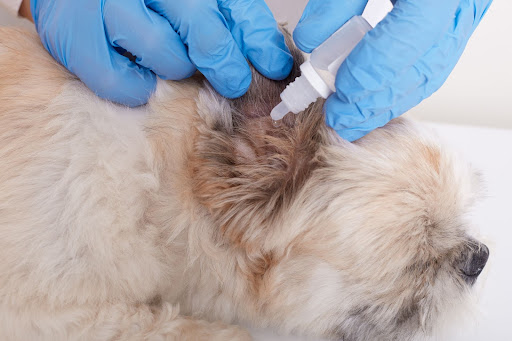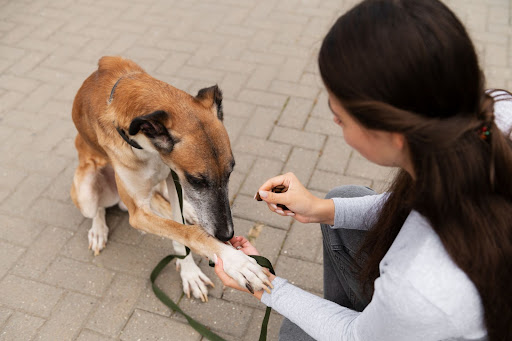Fall Allergies In Dogs
As the temperature drops and autumn sets in, many of us eagerly anticipate the change of season. However, for our canine companions, it can also mean the onset of allergies. Like humans, fall allergies in dogs are common, and the shift in weather can bring about a range of symptoms that can lead to discomfort and distress. Awareness of the indicators and remedies for fall allergies in dogs is crucial. In this article, we will review everything you need to know about dog fall allergies, such as the indications, treatments, and more.

What are Seasonal Allergies in Dogs?
Autumn dog allergies are a type of environmental allergy caused by allergens that are present in the air during the fall season. These allergens can include pollen from plants such as ragweed, sagebrush, and goldenrod, as well as mold spores. Dogs with fall allergies will typically experience symptoms such as itchy skin, red and irritated skin, and watery eyes.
Fall season allergies are different from other types of environmental allergies in that they only occur for a few months out of the year. This is because the allergens that trigger fall season allergies are not present in the air during other times of the year.
Dogs that live in areas with mild winters may experience fall-season allergies for a longer period, as the allergens may not be killed by frost.
If you think your dog may have fall season allergies, it is important to take them to the vet to get a diagnosis and treatment plan. The vet may recommend a variety of treatments, such as antihistamines, corticosteroids, and immunotherapy.

Symptoms Of Fall Allergies in Dogs
Dogs with fall allergies may experience a variety of symptoms, including:
- Itchy skin, especially on the paws, belly, and inner thighs.
- Red skin, rashes, scabs, or skin infections.
- Chronic ear infections or smelly ears.
- Watery or red eyes.
- Less common symptoms include sneezing, coughing, and digestive upset.
These symptoms can be present for just one season or year-round, depending on the dog’s allergens and the severity of their allergies. Any breed of dog can be affected. Environmental allergies are caused by allergens in the air, such as pollen, mold, and dust mites which can be mild or severe. There is no cure for environmental allergies, but there are treatments that can help to manage the symptoms. If you think your dog may have environmental allergies, it is important to take them to the vet for a diagnosis and treatment plan.
Types of Seasonal Allergies
Fall season allergies in dogs are typically caused by pollen from plants that release it into the air during the fall season. Other types of fall season allergies can include:
- Allergies to contact with plants
- Allergies to dust mites
- Allergies to mold
- Allergies to fleas
Allergies to Contact with Plants
Ragweed allergy is a type of environmental allergy that is caused by pollen from ragweed plants. Ragweed is a common weed that grows in many parts of the world, and its pollen season typically lasts from late summer to early fall.

Symptoms
Dog autumn allergies to ragweed are just like humans. Symptoms of ragweed allergy in dogs can include:
- Itchy skin, especially on the paws, belly, and inner thighs
- Red skin, rashes, scabs, or skin infections
- Chronic ear infections or smelly ears
- Watery or red eyes
- Sneezing
- Coughing
Treatment
If your dog develops symptoms, treatment involves breaking the itch cycle. A vet may prescribe a combination of therapies, including vegan shampoos, topical medications, oral medications (corticosteroids, Apoquel), or injectable treatments (Cytopoint).
It’s difficult to prevent exposure to ragweed because it releases pollen, but you can help reduce your dog’s contact by keeping them indoors during peak season (mid-September), keeping the windows closed, and using air purifiers.
Allergies to Dust Mites
Dust and dust mites are other common allergens in the fall. They are often kicked up into the air when the heating system is turned on for the first time in the season, and they are so small that they are invisible to the naked eye. Dust mites can also become a bigger problem in the fall when people spend more time indoors.

Symptoms
Symptoms of a dust mite allergy in dogs can include:
- Itchy skin
- Rash and inflammation
- Red and/or oozing skin
- Excessive licking and/or scratching
- Watery eyes and nose
- Sneezing or coughing
- Difficulty breathing (in severe cases)
Dust mite allergies are often mistaken for other chronic conditions, such as atopic dermatitis because they can be difficult to diagnose and treat. However, respiratory symptoms, such as sneezing and coughing, are a characteristic sign of dust mite allergy that does not occur with other chronic skin allergies.
Treatment
To prevent fall allergies in dogs, the first step for getting rid of symptoms is to treat the skin with corticosteroids, antihistamines, and other topical ointments. You can also bathe your dog in cool water with a vegan shampoo to reduce the risk of infection and alleviate itching.
It’s also important to vacuum as much as possible, and regularly wash dog beds, sheets, pillows, and anything else your dog comes in contact with in hot water to kill dust mites and remove allergens.
Allergies to Mold
Mold is a fungus that is always present in the environment, both indoors and outdoors. However, it can be especially prevalent in the fall due to the dampness of the season. This moisture can trigger more rapid mold growth, and piles of leaves on the ground and other decaying plant material provide the perfect breeding ground for the fungus.

Symptoms
The most common symptoms of dogs with fall allergies are:
- Excessive itching and scratching
- Red and/or scaly skin
- Thickened skin
- Hot spots and skin infections
- Chewing on paws
- Ear infections and/or shaking of the head
- Hair loss
- Sneezing, wheezing, and/or labored breathing
- Watery eyes
- Runny nose
Treatment
If you think your dog may have a mold allergy, it is important to take them to the vet for a diagnosis and treatment plan. The vet will likely recommend that you remove the mold from your home, if possible. You can do this by using a dehumidifier to reduce humidity levels, cleaning up any moldy areas with a bleach solution, and consulting with a mold remediation expert.
In addition to removing the mold, your vet may also prescribe medications to treat your dog’s symptoms. These medications may include antihistamines, corticosteroids, and antibiotics.
Allergies to Fleas
In autumn dog allergies, and allergies to fleas are especially common due to the cooler, damper weather. Not every dog is allergic to fleas, but dogs with environmental allergies are more likely to have an allergic reaction to a flea bite. This condition is known as flea allergy dermatitis (FAD).
FAD is caused by an allergic reaction to the saliva of fleas. When a flea bites a dog, it injects saliva into the dog’s skin. This saliva contains proteins that can trigger an allergic reaction in some dogs.

Symptoms
The characteristic signs of a flea allergy in dogs are:
- Itchy skin
- Hair loss
Skin and blood tests can be used to confirm or rule out a flea allergy as the cause of your dog’s symptoms.
Treatment
Treatment for flea allergies involves getting rid of the fleas and managing the symptoms.
If your dog is very uncomfortable, your veterinarian may recommend topical ointments to help reduce itching in the short term. However, the only way to cure a flea allergy is to get rid of the fleas.
You will need to treat your dog for an active infestation and likely treat your home with flea powder as well. Once the infestation is cleared up, it is important to use oral and/or topical flea prevention to prevent recurring problems.
Preventing and Managing Your Dog’s Fall Allergies
Fall can be a challenging season for our canine companions, as it brings about a surge of allergens such as pollen, ragweed, mold, and other plant-related irritants. These allergens can trigger uncomfortable symptoms in dogs, including itching, skin irritation, sneezing, and more. While there’s no foolproof way to completely prevent fall allergies in dogs, there are several proactive measures that can help mitigate the risks and manage their symptoms effectively.

Avoid Allergens
One of the most effective strategies to prevent symptoms is to identify and avoid potential allergens. However, this is not always feasible, especially for microscopic allergens like dust mites. Nevertheless, being mindful of the environment and minimizing exposure to known allergens can significantly reduce the risk of triggering allergies.
Medication
Starting antihistamine medication early, before the onset of fall allergies, can be beneficial. Antihistamines can help mitigate allergic reactions by blocking histamine, a substance released by the immune system in response to allergens. Consulting a veterinarian to determine the appropriate antihistamine and dosage for the dog is crucial to ensure safe and effective treatment.
Vaccination
Strategic timing of vaccinations can also play a role in managing fall allergies. Avoiding vaccinating dogs during the peak allergy seasons, such as spring and fall, can help minimize immune system stimulation during a period when allergies are likely to be more prevalent. Since allergies are closely related to the immune system, this approach can be beneficial in reducing the overall burden on the dog’s immune response.
Hypoallergenic Dog Food
Food can exacerbate allergy symptoms in dogs, even if it’s not the primary cause of their allergies. Opting for hypoallergenic dog food or controlling their diet can help manage symptoms and reduce the impact of fall allergies. Many dogs with seasonal allergies may also have concurrent food allergies, making it essential to address dietary factors that could worsen their symptoms.
Reduce the Itch
If a dog exhibits signs of allergies, providing relief from itching and discomfort is a priority. Anti-allergy therapy, such as over-the-counter corticosteroids or prescription medications like Apoquel and Cytopoint, can be effective in reducing itchiness, discomfort, and the risk of secondary infections. It’s essential to consult a veterinarian to determine the appropriate treatment based on the dog’s specific condition and needs.
Bathing
Regular bathing with cool water and non-fragranced shampoo during allergy seasons can help manage allergies by reducing the amount of surface pollens and contaminants on the dog’s skin. This simple yet effective practice can contribute to the dog’s overall comfort and well-being during the fall.
Introduce Supplements in the Diet
Supplementing a dog’s diet with omega-3 fatty acids, such as those found in fish oil, can have anti-inflammatory effects that may benefit dogs with allergies. Omega-3 fatty acids can help reduce inflammation and support the dog’s immune system, potentially alleviating allergy symptoms. Consulting a veterinarian for recommendations on the appropriate dosage and type of omega-3 supplement is essential to ensure its efficacy and safety.
Conclusion
In conclusion, fall allergies in dogs can pose significant challenges for our furry companions, particularly during the autumn months when various allergens like pollen, ragweed, mold, and certain plants are prevalent in the air. These allergens can lead to uncomfortable symptoms for dogs, including itching, skin irritation, sneezing, and more. Pet owners need to be attentive to their dog’s health during this season and consult a veterinarian if they suspect allergies.
With appropriate treatment, such as antihistamines, allergy shots, or dietary adjustments, along with proactive measures like regular grooming and keeping indoor environments clean, we can help alleviate our dogs’ discomfort and improve their overall quality of life during the fall allergy season. Being informed and proactive in managing dog autumn allergies is key to ensuring our beloved pets can enjoy a happy and healthy life year-round.



